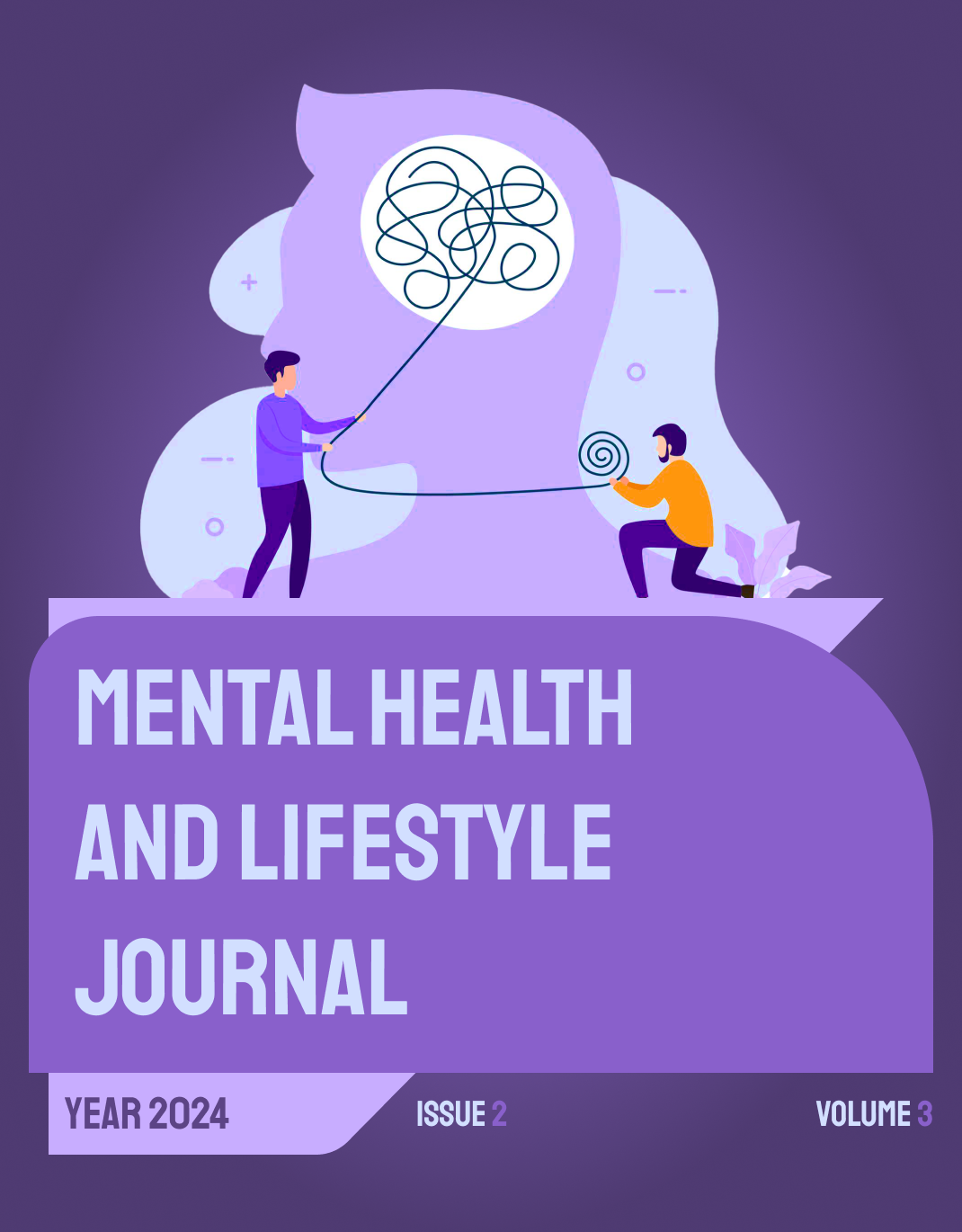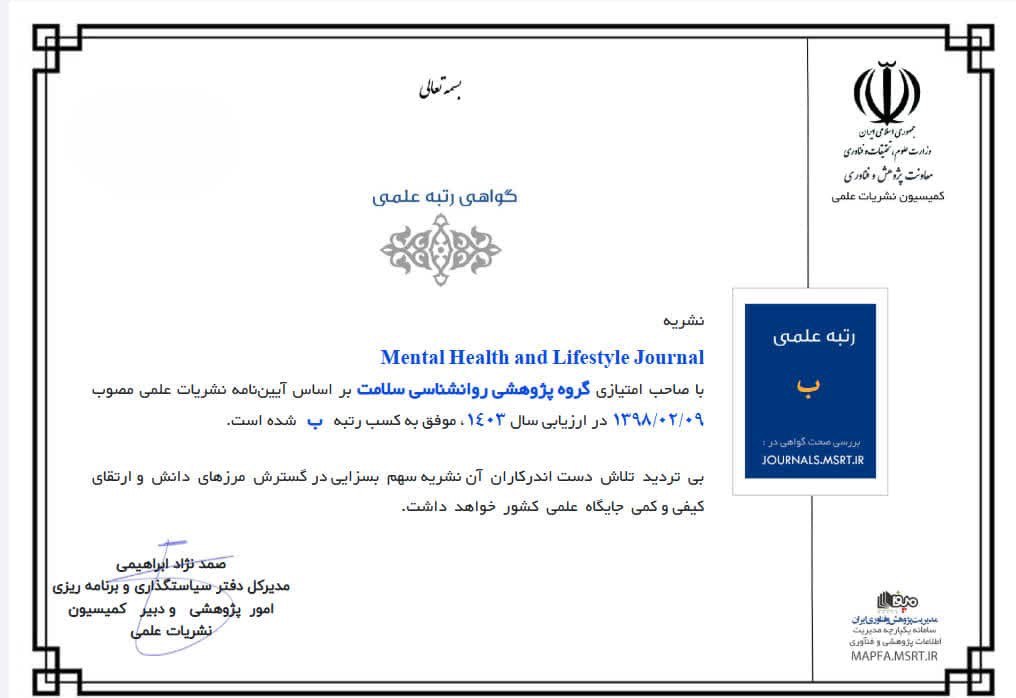Analysis of the Components of a Hope-for-Life Training Package Based on Acceptance and Commitment Theory in Adolescents with High-Risk Behaviors
Keywords:
training package, hope for life, acceptance and commitment, adolescents, high-risk behaviorAbstract
This study was conducted with the aim of analyzing the components of a hope-for-life training package based on Acceptance and Commitment Theory (ACT) among adolescents exhibiting high-risk behaviors. Accordingly, this research employed a qualitative design using the content analysis method of Hsieh and Shannon (2005). The research corpus included all texts related to hope for life and Acceptance and Commitment Theory. Based on the criterion of saturation, ten texts were selected according to predetermined inclusion and exclusion criteria. These texts were analyzed using the five-step method of Hsieh and Shannon (2005). The findings of the study indicated that hope for life in adolescents consists of several core concepts, including: (1) behavioral regulation (problem-solving, goal-directed behavior, self-efficacy, and interpersonal skills); (2) emotional regulation (acceptance of negative emotions and mindfulness); and (3) cognitive regulation (positive thinking, optimism, and cognitive flexibility). The content analysis of texts related to Acceptance and Commitment Theory revealed six core dimensions of the theory: (1) acceptance, (2) present-moment awareness, (3) cognitive defusion from dysfunctional thoughts, (4) values clarification, (5) setting and pursuing effective goals, and (6) self-as-context. These six dimensions were documented and recurrent across the literature. The components of the training package were derived from the integration of the two sets of concepts from the two content analyses and were presented as follows: cognitive defusion from ACT was aligned with enhancing cognitive regulation; three training components—living in the present moment, values identification, and committed action—were identified as related to behavioral regulation. Finally, acceptance of negative emotions and present-moment awareness were associated with the domain of emotional regulation. Based on these results, it can be concluded that the concepts of hope for life in adolescents are integrable within the framework of Acceptance and Commitment Theory.
Downloads
References
1. Magalhães P, Pereira B, Oliveira A, David Rafael Alves dos S, Pérez JCN, Rosário P. The Mediator Role of Routines on the Relationship Between General Procrastination, Academic Procrastination and Perceived Importance of Sleep and Bedtime Procrastination. International Journal of Environmental Research and Public Health. 2021;18(15):7796. doi: 10.3390/ijerph18157796.
2. Chen D, Zhang Y, Lin J, Pang D, Cheng D, Si D. Factors Influencing Bedtime Procrastination in Junior College Nursing Students: A Cross-Sectional Study. BMC Nursing. 2022;21(1). doi: 10.1186/s12912-022-00881-7.
3. Cui G, Yin Y, Li S, Chen L, Liu X, Tang K, et al. Longitudinal Relationships Among Problematic Mobile Phone Use, Bedtime Procrastination, Sleep Quality and Depressive Symptoms in Chinese College Students: A Cross-Lagged Panel Analysis. BMC Psychiatry. 2021;21(1). doi: 10.1186/s12888-021-03451-4.
4. Herzog-Krzywoszańska R, Jewula B, Krzywoszański Ł. Bedtime Procrastination Partially Mediates the Impact of Personality Characteristics on Daytime Fatigue Resulting From Sleep Deficiency. Frontiers in Neuroscience. 2021;15. doi: 10.3389/fnins.2021.727440.
5. Hong L, Xu H, Zheng J, Lin X, Wang L, Zhao C, et al. Latent Profiles and Transitions of Bedtime Procrastination Among Chinese College Students: The Predictive Roles of Anxiety, Depression, Problematic Smartphone Use and Self-Control. Nature and Science of Sleep. 2024;Volume 16:801-11. doi: 10.2147/nss.s462055.
6. Deng Y, Ye B, Yang Q. COVID-19 Related Emotional Stress and Bedtime Procrastination Among College Students in China: A Moderated Mediation Model. Nature and Science of Sleep. 2022;Volume 14:1437-47. doi: 10.2147/nss.s371292.
7. Yasin N, Mushtaq R, Karamat A. Bedtime Procrastination, Sleep Disturbance, Fatigue and Mental Health in Female University Students: Mediation Analysis. Journal of Professional & Applied Psychology. 2024;5(2):215-23. doi: 10.52053/jpap.v5i2.271.
8. Cemei L, Sriram S, Holý O, Rehman S. A Longitudinal Investigation on the Reciprocal Relationship of Problematic Smartphone Use With Bedtime Procrastination, Sleep Quality, and Mental Health Among University Students. Psychology Research and Behavior Management. 2024;Volume 17:3355-67. doi: 10.2147/prbm.s472299.
9. Bild E, Rossa K, Edmed SL, Pattinson C, Mann D, Gadam S, et al. O072a the Relationship Between Bedtime Procrastination, Habitual Smartphone Use, and Sleep in Young Adults: Results From the Young Adult Health Study (YAHS). Sleep Advances. 2024;5(Supplement_1):A52-A3. doi: 10.1093/sleepadvances/zpae070.151.
10. Hammoudi SF, Mreydem HW, Ali BTA, Saleh NO, Chung S, Hallit S, et al. Smartphone Screen Time Among University Students in Lebanon and Its Association With Insomnia, Bedtime Procrastination, and Body Mass Index During the COVID-19 Pandemic: A Cross-Sectional Study. Psychiatry Investigation. 2021;18(9):871-8. doi: 10.30773/pi.2021.0120.
11. Song J, Ahmed O, Lee T. Validation of the Bedtime Procrastination Scale Among Korean High School Students During the COVID-19 Pandemic. Sleep Medicine Research. 2024;15(4):255-61. doi: 10.17241/smr.2024.02544.
12. Zhu Y, Liu J, Wang Q, Huang J, Li X, Liu J. Examining the Association Between Boredom Proneness and Bedtime Procrastination Among Chinese College Students: A Sequential Mediation Model With Mobile Phone Addiction and Negative Emotions. Psychology Research and Behavior Management. 2023;Volume 16:4329-40. doi: 10.2147/prbm.s431615.
13. Feng Y, Meng D, Guo J, Zhao Y, Ma X, Zhu L, et al. Bedtime Procrastination in the Relationship Between Self-Control and Depressive Symptoms in Medical Students: From the Perspective of Sex Differences. Sleep Medicine. 2022;95:84-90. doi: 10.1016/j.sleep.2022.04.022.
14. Hou X, Hu J. Depression and Bedtime Procrastination: Chain Mediation of Brooding and Perceived Stress. Heliyon. 2023;9(12):e22672. doi: 10.1016/j.heliyon.2023.e22672.
15. Bistricky SL, Kenigsberg Z, Klein P, Feliciano L. 0934 Self-Compassion, Bedtime Procrastination, Sleep, and Mental Health in Individuals Exposed to Trauma. Sleep. 2024;47(Supplement_1):A401-A. doi: 10.1093/sleep/zsae067.0934.
16. Zavardeh SZM, Ashoori M, Bazzāziān S. Self-Compassion in the Relationship Between Personality Traits and Bedtime Procrastination. Journal of Social Behavior and Community Health. 2024. doi: 10.18502/jsbch.v8i1.15612.
17. Zhu Y, Wang Q, Liu J, Huang J. Parental Psychological Control and Depression, Anxiety Among Adolescents: The Mediating Role of Bedtime Procrastination and Moderating Role of Neuroticism. Archives of Psychiatric Nursing. 2024;51:1-9. doi: 10.1016/j.apnu.2024.05.002.
18. Geng Y, Gu J, Wang J, Zhang R. Smartphone Addiction and Depression, Anxiety: The Role of Bedtime Procrastination and Self-Control. Journal of Affective Disorders. 2021;293:415-21. doi: 10.1016/j.jad.2021.06.062.
19. Huang J, Yang Z, Wang Q, Liu J, Xie W, Sun Y. The Relationship Between Family Cohesion and Bedtime Procrastination Among Chinese College Students: The Chain Mediating Effect of Coping Styles and Mobile Phone Addiction. BMC Psychiatry. 2024;24(1). doi: 10.1186/s12888-024-05700-8.
20. Dardara EA, Al-Makhalid KA. Investigating the Relationship Between Bedtime Procrastination, Psychological Stress, and Mental Health Among Saudi Undergraduate (Preprint). 2021. doi: 10.2196/preprints.28557.
21. Carlson SA, Williams P. 0336 Workday Rhythms and Bedtime Behaviors: The Role of Work Timing and Duration in Bedtime Procrastination. Sleep. 2024;47(Supplement_1):A144-A5. doi: 10.1093/sleep/zsae067.0336.
22. Carlson SA, Johnson K, Williams P. 0197 to Delay Perchance to Sleep: The Daily Association Between Pre-Sleep Arousal and Bedtime Procrastination. Sleep. 2023;46(Supplement_1):A87-A8. doi: 10.1093/sleep/zsad077.0197.
23. Bistricky SL, Lopez AK, Pollard T, Egan A, Gimenez-Zapiola M, Pascuzzi B, et al. Brief Multimodal Intervention to Address Bedtime Procrastination and Sleep Through Self-Compassion and Sleep Hygiene During Stressful Times. 2023. doi: 10.1101/2023.04.16.23288655.
24. Xu C, Lin N, Shen Z, Xie Z, Xu D, Fu J, et al. Bedtime Procrastination Related to Loneliness Among Chinese University Students During Post-Pandemic Period: A Moderated Chain Mediation Model. BMC Public Health. 2024;24(1). doi: 10.1186/s12889-024-18019-6.
25. Roy RS, John SMT, John JM. Bedtime Procrastination and Thought Control Among Hostellers And Day Scholars. International Journal of Engineering Technology and Management Sciences. 2022;6(5):498-504. doi: 10.46647/ijetms.2022.v06i05.077.
26. Uygur ÖF, Bahar A. Sleep Effort and Insomnia Severity: The Role of Bedtime Procrastination. Sleep Medicine Research. 2023;14(1):18-24. doi: 10.17241/smr.2023.01655.
Downloads
Published
Submitted
Revised
Accepted
Issue
Section
License

This work is licensed under a Creative Commons Attribution-NonCommercial 4.0 International License.










